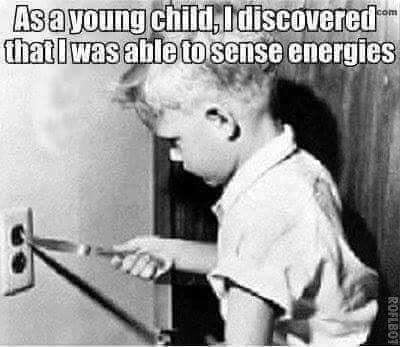Hello and welcome to day 4.
For the past two days we have worked with vision, one of the most common senses we refer to when discussing “intuitive” abilities. But it certainly isn’t the only sense! Indeed, all 5 physical senses are tied to our intuitive abilities, plus many more non-physical senses!,
We use our physical senses daily to experience and to interpret our environment. But we often limit what we will allow them to sense based on what we “believe” to be true. In order to expand the functioning of our physical senses, we only have to understand that from one perspective, our bodies don’t actually end where we think they do. What does this mean?

By now you’ve heard of the term Aura. Our energy body, or Aura, is simply an extension of “us”. It is finer, and more subtle, but at the end of the day it is still us. When we walk into a room, we take up space in two ways – what most people see as our physical person, and then by how expansive our aura is.
Because our Aura is part of us, there is no reason we should not be able to access it when perceiving our environment.
Working with the feeling sense should provide a good example of how this works.., which is the topic of today’s conversation.
Find this page by accident? Want to take the whole course? For FREE?
Let’s Get Started With Day 4
For many people, feeling is the first sense they connect to. There are two basic types of “feeling” senses – one is related to our physicality, the other is related to our emotional body, also referred to as our “feelings”. The emotional sense will be covered in lesson 5. Today we are going to spend time on the physical feeling sense.

Think of your aura – an energy field extending out beyond your physical body. When something enters this energy field, you can “feel” it? Most of us tune this out, or ignore it, therefore we do not make use of this wonderful sense. But even the most blocked of us have moments when we turn around because we “feel” someone is staring at us. Or we move suddenly because we “feel” that someone is crowding our space. Even if they aren’t actually touching us, we feel as if we have been connected in some way. And sometimes that makes uncomfortable.
Today’s exercise is an audio recording you can click on below. We will work with using our hands to feel the energy around our bodies.
Exercise: Feeling Energy
listen to the exercise here: (Or simply read on)
Get yourself in a comfortable, seated position. Now, rub your hands together in order to get the energy flowing.
Take your hands and hold them about six inches apart, palms facing each other. Play around with moving your hands closer and further apart. can you feel the energy between your hands? How it may come to you is in a form of a little bit of resistance as you move your hands together and apart. Another way of sensing this would be a bit of tingling, or odd pressure in your fingers or palm.
Can you form and shape your hands to form an invisible “ball” of energy?
Another way we can perform this exercise is to take your hand and place it over another part of our own body. Perhaps your leg, or thigh (if you’re sitting down). Can you feel the energy here?
How about a pet. Instead of actually touching your pet, hover your hands over them and see if you can feel any sensations.
You can do this with plants as well. Even crystals and rocks have energy fields you can tune into. The key is that the more vitality, or “life force” something has, the easier this exercise will be.
As time goes on, you will develop an ability to feel nuances in energy. For example, some objects that are more dense have a deeper feeling, or energy to them, whereas typically less dense objects feel “lighter”, or more floaty. This is a more advanced concept that can be felt in time. For now, simply focus on anything you can receive and work from there.
Recap of Today’s Exercise
Everything has energy. Some of it is more noticeable than others. Some things are more noticeable because they have more life force, or more vitality. Some things are more noticeable because of our own personal preferences, i.e. we either really love it or really dislike it.
- What is the point of learning to “feel” energy?
- And what if you feel something “icky”, or something you don’t like the feel of?
- Isn’t it best to simply not develop your senses, therefore you don’t have to feel something negative?
Some energies we come in contact with will feel supportive, and some may feel like they drain our life force. Some of this is personal. For example, with music, some are inspired by classical music, whereas others enjoy listing to rock music. Neither is “bad”, per se, yet they are not always supportive to different people. When we know what music we like, we can always put that music on and uplift our day. Music, sound, and frequency are keys to changing energies and moods.
Often, what affects us on a daily basis is much more subtle. But when we do learn to feel and identify these more subtle energies … when we do come across something we don’t resonate with, it can be much easier to deal with. It can be more like coming across a speed bump in the road as opposed to a complete road block. When we see a speed bump, we can simply slow down, drive over it, and then keep going on our merry way! When we don’t recognize energies that affect us, often we just stand in them for far too long and then wonder why we suddenly have a headache, or worse. Awareness is key!
The more we pay attention to our surroundings, the easier it will be to “go around” things we don’t want, and to navigate towards situations we enjoy and wish to be around.
Practice!
What do children do? They pick things up. They spin them. The drop them. They pick them up. They put them in their mouth. They throw them.
They engage with their surroundings. They test an object’s properties.
While it may not be appropriate to run around touching everything and putting things in our mouths, we can still learn a thing or two from how children behave. They are constantly tuning into their environment. They are constantly observing and testing objects and people for their properties. The more we engage with our environment, the more we can learn from our surroundings.
Key Takeaways From the Exercise:
- The more “alive” something is, the easier it will be to feel the energy field (see it as well)
- Energy fields can be subtle, and it takes practice becoming aware of the nuances
- Feeling energy and learning to discern differences is a skill. It can be practiced.
- Practice by becoming engaged. Touch things. Explore. Be curious.
- As we master our ability to perceive our environment and our surroundings, we will find it much easier to place ourselves in surroundings that we enjoy and are more compatible with our own interests.
